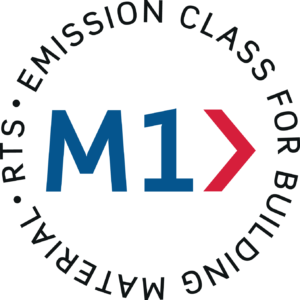2/3/2023
Nor-Maali´s water-borne coatings Akvanor 100 SG, Akvanor 81 Primer and Norepox Aqua DTM have received the M1-classification. The products have passed the strictest classification for building material emissions prepared by the Finnish Society of Indoor Air Quality and Climate.
The aim of the M1-classification is to enhance the development and use of low-emission building materials. A good indoor climate in a building requires consideration of indoor air issues in all stages of planning, construction and use. Good indoor air is influenced by the building materials of the interior, along with many other factors.
Akvanor 100 SG is a fast drying, acrylic based water-borne semi-gloss coating with rust preventing pigments. It is suitable as primer or topcoat as well as a direct to metal coating on steel surfaces in environment classes C1-C3. Akvanor 100 SG has been tested according to standard ACT Volvo STD 423-0014 (rev. 6) and it meets the requirements. Akvanor 100 SG has also quality system approval according to MarineEquipment Directive 2014/90/EU.
Akvanor 81 Primer is a water-borne anti-corrosion primer based on an acrylic binder. It is recommended in moderate corrosive environments (C1-C3). The product is a part of a complete system which meets the requirements of IMO FTPC being a material with low flame-spread characteristics and not producing excessive quantities of smoke and toxic products at elevated temperatures (Certificate NO VTT-C-11308-15-15).
Norepox Aqua DTM is a quick drying, water-borne two-component epoxy coating with polyamine adduct curing agent. Product contains rust preventing pigments. Norepox Aqua DTM is recommended to use as a primer, topcoat or direct-to-metal coating in epoxy paint systems in environmental classes C2-C4. It can be overcoated with polyurethane coatings.

The M1 classification sets limit values for the emissions of certain substances and odour of building materials used indoors, such as paints and coatings. In Finland, the Finnish Society of Indoor Air Quality and Climate has drawn up a classification for building materials, according to which the products are divided into three categories:
| Parameter | Emission class M1 | Emission class M2 |
| Total volatile organic compounds (TVOC) emissions [mg/m2h] | ≤ 0.2 | ≤ 0.4 |
| Emissions of volatile organic compounds (VOC) [µg/m3] 1 | ≤ EU-LCI | ≤ EU-LCI |
| Formaldehyde emissions [mg/m2h] | ≤ 0.05 | ≤ 0.125 |
| Ammonia emissions [mg/m2h] | ≤ 0.03 | ≤ 0.06 |
| Emissions of CMR compounds (category Carc. 1A or 1B in Annex VI to Regulation (EC) No 1272/2008) [mg/m3] 1 | ≤ 0.001 | ≤ 0.001 |
| Odour 2 | acceptable | acceptable |
1) does not include formaldehyde, 2) odour acceptance ≥ 0.0
The emission classification of building materials is a voluntary labelling system. All manufacturers, importers and exporters of building materials can apply it for their products.
The M1 classification is granted by The Building Information Foundation (Rakennustietosäätiö – RTS). The product classification requires measurements performed by neutral third-party laboratory and which under the test conditions fulfills the M1-certification criteria. Emission of VOC, formaldehyde, ammonia and CMR compounds are measured. Also the acceptability of the odour associated with the material is assessed. Measurements are taken four weeks after applying the product.
Rakennustieto (Building Information) maintains and publishes a freely accessible database. All products with valid M1-certificate can be found in the database using the search function.